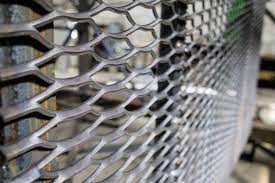If you’re not familiar with expanded metal, it would be a good idea to get to know it, as it’s actually a very versatile material that can be used in many different contexts. Essentially, expanded metal is created by putting a sheet of metal through a shear-form process. During this process, the sheet of metal is put under multiple knives, which then inserts slits and simultaneously stretches them out. What you’re left with on your sheet of metal is a pattern of diamond-shaped mesh, the composition of which allows it to be very strong relative to how much it weighs. In addition to its many construction applications, using expanded metal (which can be made from basically any type of metal, including aluminum or steel) can also be a very environmentally friendly decision. Because the metal, during the expansion process, is slit by the knives rather than being punched through, you aren’t wasting any pieces of the material. Because of this, expanded metal is typically a very green construction material. So, you’re probably wondering when to utilize this in your construction projects. There are several worthwhile applications of this material, and we will cover some of them here. Supporting Structures Because of its raised mesh pattern, many builders utilize expanded metal for supporting things like masonry, tile, and stone veneers, as it provides an excellent surface for keying plaster (a process that allows for more effective adhesion). Expanded metal is also frequently used to support parts of a building that are more likely to suffer cracks, such as the edges of doors and windows, or in any corners where a wall intersects with the ceiling or a different wall. Because of its light weight and versatility, it can be utilized as a means of support for a variety of different surfaces and structures. Keeping a Jobsite Safe & Secure Another excellent benefit of expanded metal is that it can be used to increase the safety at a construction jobsite. For example, workers falling through skylights is a very real risk at any worksite, but using this material as a screen can prevent it from happening. Additionally, the material has anti-slip properties, so if utilized strategically, it can be placed over the more slick places in the work area to help prevent workers from taking any nasty falls. In terms of the actual construction applications, it can also keep whatever structure or facility is being built safer, by being used on scaffolding, walkways, or even staircases. You don’t want your construction workers slipping and falling, but you certainly don’t want pedestrians or residents slipping and falling once the project is done, either! Expanded metal can also be used as an effective deterrent for any potential burglars or vandals. For one, large amounts of this material can be set up as a type of fence around whatever you want to keep secure, whether it be an entire jobsite or just a specific collection of equipment. Alternatively, due to its versatility, small lockers or storage boxes can also be constructed from it, if you just need to keep a smaller object safe and secure. Because it is such a strong material, businesses and facilities have been trusting fences and barriers made from it to keep their important property secure for many years. Filtration When you need to filter things like grease or oil from any of your more heavy duty construction equipment, expanded metal can serve as an excellent tool, due to its inherent strength. When you use it within your filtration system, it can be very effective at filtering out the vast majority of the bigger contaminants and particles, which takes a ton of stress off the filter itself. Not only will this help your heavy equipment run more smoothly, but it will also allow your filter to do its job more efficiently. Because of how well it does this job, it is typically one of the most common types of metal that professionals prefer to use when it comes to filters for heating and air conditioning systems, as well. Decoration Because it can be slit with nice-looking patterns, and be coated with various paints or markings, expanded metal can be an aesthetically-pleasing material to use for many different decorative or display purposes. Whether you choose to construct a professional looking fence or walkway, or just use it as an outer layer for the surface of a building, outdoor furniture, or really any types of outdoor structures that you may be putting together, it tends to look good. Many people praise this building material, mostly for its impressive functionality, but it is also frequently found to be quite pleasing to the eye. All over the world, it is becoming more and more common for it to be used simply as a way to make a building facade, a ceiling, or a sidewalk look unique. Since it’s so light-weight, and versatile in the sense that it can be made from so many different types of metal and fitted to so many different purposes, there is really no end to the uses you can find for it. In Conclusion As you can tell, there is no shortage of ways to utilize this product into your construction project. If you are using it to improve your actual construction working conditions, and are only interested in its usefulness and functionality, you will certainly not be disappointed. When set up the right way, it will not only greatly lower the chances of you or any other workers injuring themselves on the job, but it will also give you peace of mind that everything stays secure when your crew isn’t around to keep watch.On the other hand, if you’re more interested in using expanded metal to enhance the final product of the construction job, you will be happy with your results in that area as well. Overall, it will not only make the building or structure safer for its occupants, but it will make the buildings themselves sturdier













